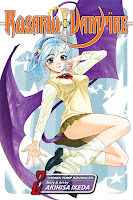Here's a number of reviews I've been meaning to write, but haven't had the time till now.
Parasyte Vol. 3
The core of Hitoshi Iwaaki's engrossing body horror series is fairly simple, if not particularly original. Teenage protagonist Shinichi Izumi forms an alliance of convenience with an alien parasite who has replaced his right hand, in order to defend against other hostile parasites. However some parasites are interested in observing this alliance. In this volume Shinichi and his parasite Migi encounter Hideo Shimada, a parasite who enrolls at Shinichi's school. He expresses a desire to integrate into human society. Meanwhile the Japanese government has become aware of the alien attacks, but has little to go on until they can capture a specimen.
Iwaaki's art isn't particularly polished. His backgrounds are perfunctory, and his figures are a bit stiff. Most characters' facial expressions don't stretch beyond surprise, fear, and anger. Not that they were written with any particular depth in the first place. Ironically the parasites that have taken over a human host develop far more interesting personalities, and their motives drive the conflict of the story. There's something a little off about the symmetry in the faces that Iwaaki renders. Intentional or not, this weakness actually helps make the parasites and Shinichi look far more malevolent. But while humanity may not be Iwaaki's forte, the depictions of unleashed parasites going on a killing spree are where he truly excels. The bloody confrontation at the end of this volume is a real visual feast and not for the easily upset.
Pretty Face Vol. 6
The final volume of this series brings the story to a very sudden end. The premise (which I discussed in my vol. 1 review) exemplifies shonen manga's ability to both titillate and thoroughly creep out the target audience - the fan service, while no more egregious than any other manga, involves gender-bending male hero Rando Masashi either staring at his unsuspecting female classmates, or the reader witnessing the androgynous Rando coming close to being exposed in front of said classmates.
The series has put Rando in most of the typical situations readers have to expect of the genre: The beach, gym class, hot springs, sports fests, sleepovers etc. Several supporting characters have been introduced, but dropped instead of being developed. Midway through the series, there was an attempt to get the whole 'find the missing sister Yuna' plot thread moving. But after running into a dead end, it reverted to the usual episodic format. This inability to follow-up on this plot thread may be the reason why Yasuhiro Kano ended Pretty Face. Instead Yuna Kurimi unexpectedly shows-up two-thirds into vol. 6, and the story rushes to its conclusion, leaving a few plot holes along the way, and not quiet resolving every issue.
Ultimately, whether readers will find Pretty Face endearing or disturbing depends on how far they can buy into the idea of a virginal teenage boy swearing undying devotion to a girl who barely knows him and thinks he's dead. Admittedly the sheer weirdness of the premise and the slickness of Yasuhiro Kano's art kept me from dropping it.
Rosario + Vampire Vol. 1
Rosario + Vampire Vol. 2
This is a by-the-numbers male fantasy. Shonen nonentity Tsukune Aono, by some twist of fate, enrolls in a school for monsters. He only figures this out after attending his first homeroom class. Naturally desiring to preserve his life, he decides to withdraw. But Moka Akashiya, the popular girl he has a meet cute with, becomes predictably attached to him, and convinces him to stay. Moka is an extremely powerful vampire, but her true abilities are suppressed by a crucifix she wears on her neck (Every student is required to remain in human form when on campus). Tsukune discovers that under duress he is the only one who can remove the cross, which is a good thing as he's in constant danger of being torn apart by his unsuspecting classmates, and sometimes by the faculty. For her part the lonely Moka considers Tsukune her first true friend. But as they settle into their daily routines, a circle of rivals/friends develops into the usual web of possible romantic entanglements; The twist being that most of the cast are supernatural monsters.
Author Akihisa Ikeda isn't the best artist I've seen, but he's skilled enough to draw the attractive female-centric cast and the requisite up-skirt panty shots. The manga is literally a monster-of-the-week series. Tsukune and Moka get involved in a certain school activity, which puts them into conflict with an antagonist. Said antagonist turns into a monster, and Tsukune is forced to unleash Moka's vampiric powers. I should point out that Moka goes through a Jekyll and Hyde personal transformation when she morphs into a full vampire. She also doesn't actually bite any of her opponents, but beats them into submission with roundhouse kicks. The 'necking' she reserves for Tsukune.
While Rosario + Vampire is a competent manga, it doesn't particularly stand-out. At least not yet.
11/30/2008
11/08/2008
11/03/2008
La Muse
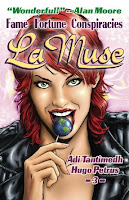 Like most kids, super-heroes functioned as a basic form of wish fulfillment - an escapist fantasy about, to quote Stephen Grant describing Superman (but applicable to the genre in general), a "Strongman who orders the world by physically imposing his will on it, to the betterment of but not necessarily with the consent of lesser men, and will do with regardless of their authorization." The onset of adolescence complicates that juvenile concept with ill-informed idealism. Young people suddenly became aware of general suffering, and wonder why grown-ups were screwing-up the world. The genre has been operating on this mode since Marvel Comics writer Stan Lee started to appeal to college kids. However the restrictions placed on super-hero universes limit how much real world issues can be raised. La Muse, created by writer Adi Tantimedh and artist Hugo Petrus, is the latest comic to attempt placing super-heroes in a more real world context. The story began online, and can still be read in this version. It's been slated to be released as a printed book later this year.
Like most kids, super-heroes functioned as a basic form of wish fulfillment - an escapist fantasy about, to quote Stephen Grant describing Superman (but applicable to the genre in general), a "Strongman who orders the world by physically imposing his will on it, to the betterment of but not necessarily with the consent of lesser men, and will do with regardless of their authorization." The onset of adolescence complicates that juvenile concept with ill-informed idealism. Young people suddenly became aware of general suffering, and wonder why grown-ups were screwing-up the world. The genre has been operating on this mode since Marvel Comics writer Stan Lee started to appeal to college kids. However the restrictions placed on super-hero universes limit how much real world issues can be raised. La Muse, created by writer Adi Tantimedh and artist Hugo Petrus, is the latest comic to attempt placing super-heroes in a more real world context. The story began online, and can still be read in this version. It's been slated to be released as a printed book later this year.On a sliding scale between idealism and Alan Moore-style gritty realism, La Muse falls closer to fantasy. The story works the angle that super-heroes would function more as celebrities than as masked vigilantes in the real world (à la Paul Chadwick's Concrete). Susan La Muse is a left-wing political activist who has been captured on camera using her superpowers. Rather than trying to cover it up, she decides to use her sudden fame to further her causes. She enlists the help of her non-powered sister Libby, a Hollywood agent. Libby isn't pleased by all the undue attention her sister is getting, and worries about the consequences of Susan's agenda. This immediately comes in the form of enemies, both personal and political, who want to stop her permanently.
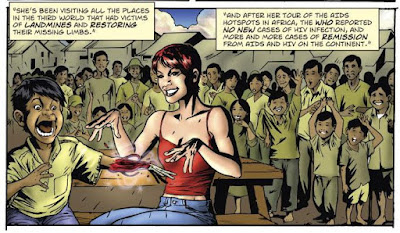
While the problems that Susan confronts are facsimiles of contemporary real-world issues, Susan La Muse offers no realistic solutions to them. This is because her powers function on a magically literal wish-fulfillment level. Global warning? Gone. Third-world hunger? Suddenly there's enough food to feed the starving. Nuclear weapons proliferation? Deactivated with a wave of the hand. It's all ridiculously easy for Susan. When asked by Libby where her agenda leads to, she responds "Just long enough for me to, you know, end suffering."
Susan's mary sueisms start with her extraordinary powers. In addition she's clever, charismatic, media-savvy, socially well-connected, attractive, and the most sexually experimental individual on the planet. She has mind-blowing sex with just about anyone (and almost anything). Sex is presented as a solution to various problems. And like a quintessential liberated woman, she prefers to make love, not war, in order to convert her enemies into allies. Since Susan is a walking deus ex machina, this makes it difficult to sustain any tension, even as Susan's ever growing list of enemies congeal into a vast right-wing conspiracy, mounting ever increasingly deadly attacks against her and her friends. But events in the later part of the story do force her to modify her tactics.
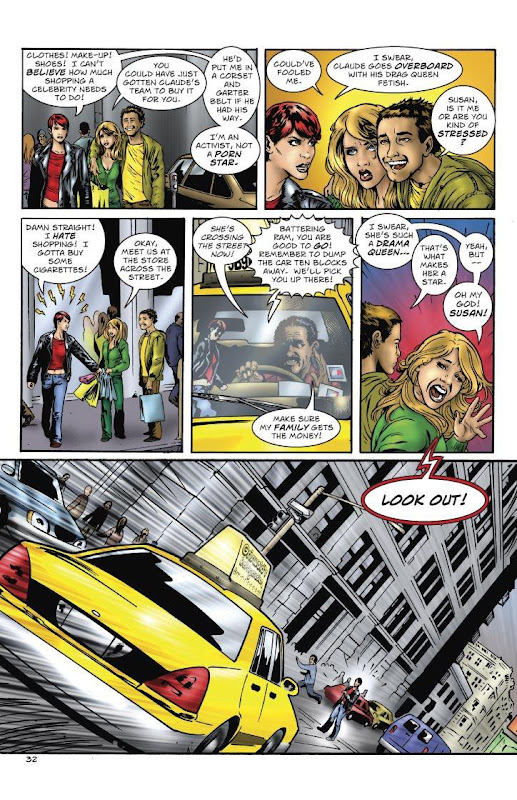
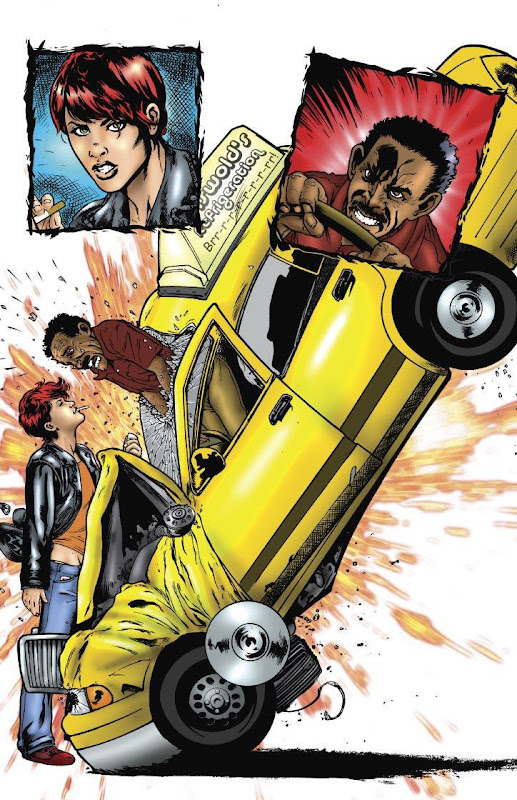
The line art for La Muse is gorgeous and more down-to-earth than the house styles that presently dominate the Big Two, which I find a relief. Despite the webcomic format, the comic conforms to the layout of the conventional nine and six panel grids. I suspect that the work was originally intended for print. The coloring however clashes with the thick, textured strokes of the line art. It feels perfunctory - bright and saturated to help define the subjects, but doesn't help improve the mood or atmosphere. Given the speed in which the comic was regularly updated, I'm impressed with how much was done. But I would have preferred to see coloring that blended more effectively with the inking.
While La Muse doesn't break new ground for the genre, it feels refreshingly new if only because it doesn't try to ape the cliches found in forty year old shared universes. It's the story of someone given the opportunity to change the world - she's actually aloud to do it, and suffer the consequences. A super-hero comic with a beginning, a middle, and an end. Is that so difficult to do?
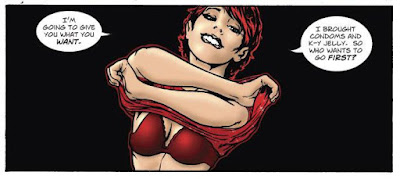
Subscribe to:
Posts (Atom)




